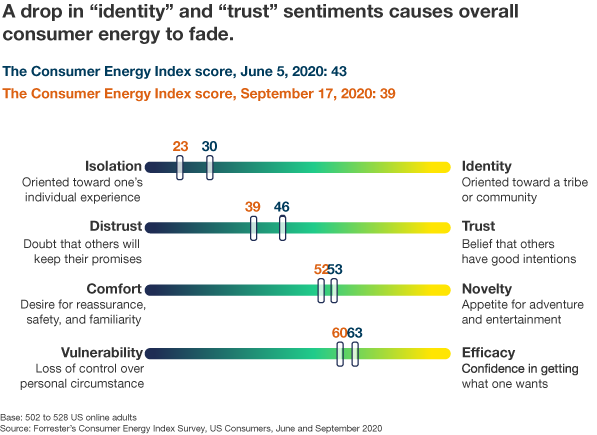Consumer Energy Fizzles To A New Low As Consumers Approach Q4
If you’ve been following my blog, you’ll know that we’ve been measuring precisely how the emotional toll of the COVID-19 pandemic is influencing consumer appetite for commercial exchange. We do this by applying Forrester’s Consumer Energy Index, our data-driven framework that captures how ready and willing consumers are to reach out to brands.
After a dramatic drop during the early months of the pandemic, consumer energy hovered at its lowest levels of the past two years. Phased business reopenings coupled with a swell of activism kindled sparks of consumer energy by early June.
Where do consumers stand today? With a mellow summer behind us, vastly varied and fragmented pandemic experiences around us, and a looming US presidential election ahead of us, we turn the corner into the final quarter of the year. A temperature check on consumer emotion reveals that consumer energy has dropped to 39 on a scale from 0 to 100 — which is a record low for 2020.

What The Data Means
At this moment:
- Current conditions exacerbate consumer feelings of isolation, disconnection, and fragmentation. Consumer energy “identity” scores have been falling ever since the onset of the pandemic in early March, as physical distancing yielded emotional isolation. The latest data indicates that neither months of virtual happy hours nor the gradual introduction of small, socially distanced gatherings are repairing consumers’ sense of loneliness. Of all four dimensions, brands will have to work the hardest to dial up consumers’ sense of community.
- Consumers are raising their guard of skepticism. After the “identity” score, consumer trust levels have remained second-lowest over the course of this year. Consumers have been apprehensive about brands’ intentions and cautious to believe that organizations will follow through on their promises. The latest 7-point drop along the “trust” dimension means that consumers are even less willing to believe that the people and organizations around them are driven by good intentions.
- Consumers are generally in the mood for novelty. Throughout the pandemic, consumers have been experiencing an emotional tug-of-war between seeking familiarity and variety. A score of 52 along the “novelty” dimension indicates that currently, consumers are somewhat intrigued by diversions that inform, delight, and entertain.
- Consumers maintain a mild confidence in their ability to recover control. Consumers’ sense of control took the biggest hit when the pandemic initially reached the US in March; since then, “efficacy” scores have remained consistent. The latest slip along the “efficacy” dimension means that consumers are relatively less energized about the idea of reaching for new tools and resources than they were in early June.
What It Means For Brands
More than six months into the pandemic, consumers continue to cope with their state of flux. Ongoing lifestyle adjustments and fragmented, conflicting guidance about safety protocols and the future of the COVID-19 virus heavily weigh down on consumers’ emotional well-being. In the churning waters of social, economic, and emotional uncertainty, brands that struggle to hold on to consumer attention, trust, and loyalty should treat the four dimensions of consumer energy as their lifelines to the consumer. CMOs, determine where and how your brand can stoke consumer energy around a renewed sense of empowerment and innovation by:
- Bolstering consumer affiliation with your brand through a shared sense of purpose. Delta Air Lines shines a spotlight on its ongoing investment in sustainability to demonstrate the authenticity and integrity of its values — even as its business bears the blow of the pandemic.
- Cultivating consumer trust by consistently delivering on a specific promise. Uber enforces its commitment to a “no mask, no ride” policy by requiring drivers to submit selfies through the Uber app that illustrate compliance and by enabling drivers and riders to report the noncompliant.
- Refreshing consumers with informative or entertaining insight. Netflix recently started allowing consumers to watch select content for free without the burden of signing up for a subscription — or even for the typical free trial.
- Arming consumers with the tools they need to regain a feeling of control. Banks such as BBVA and CaixaBank are helping late adopters get a handle on digital banking by offering step-by-step guides on how to sign in online and friendly videos “by the elderly, for the elderly” with security tips to feel safe while conducting online transactions.
Questions, comments, or ideas? I look forward to sharing more data detail and discussing via an inquiry.
